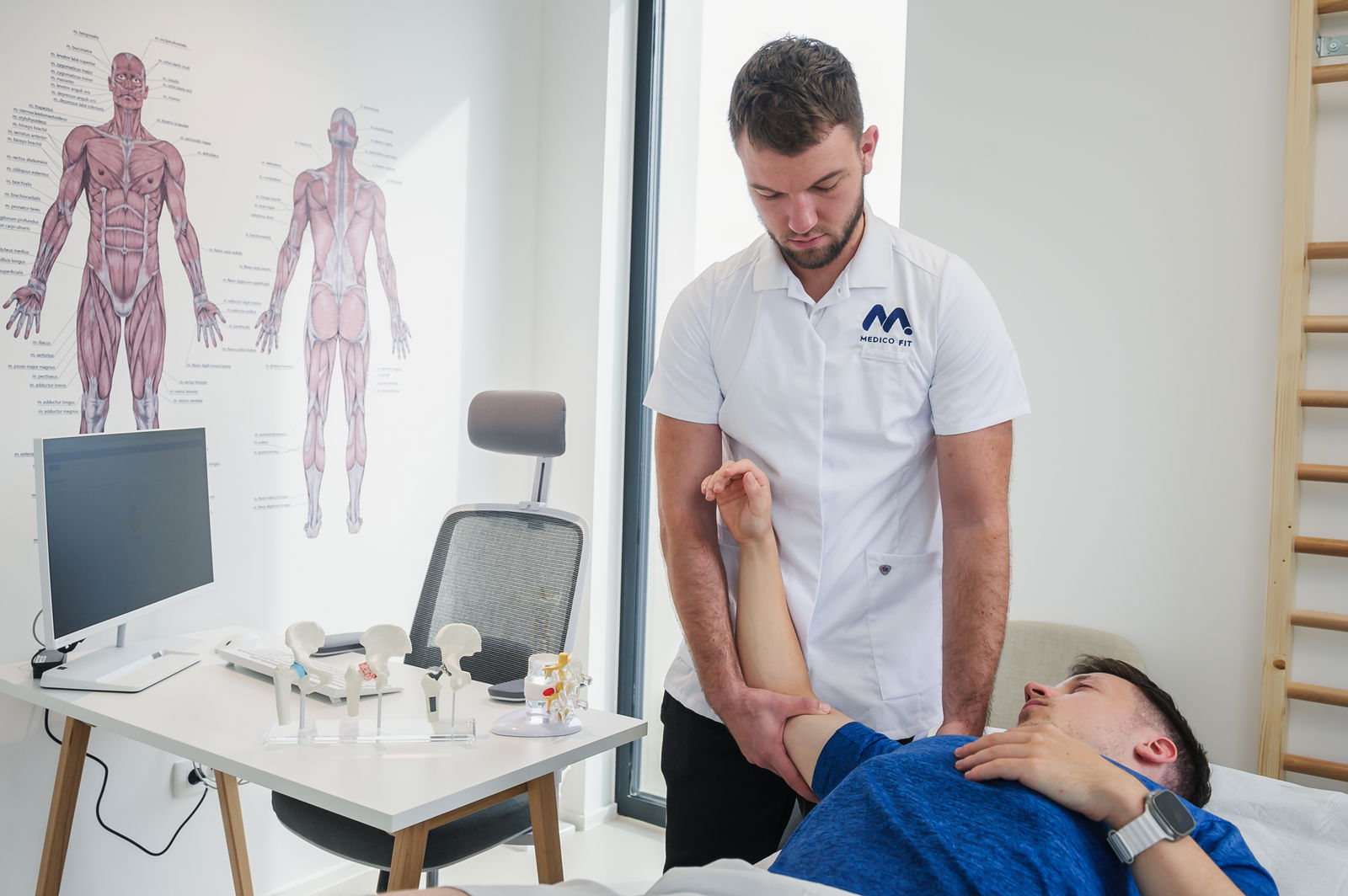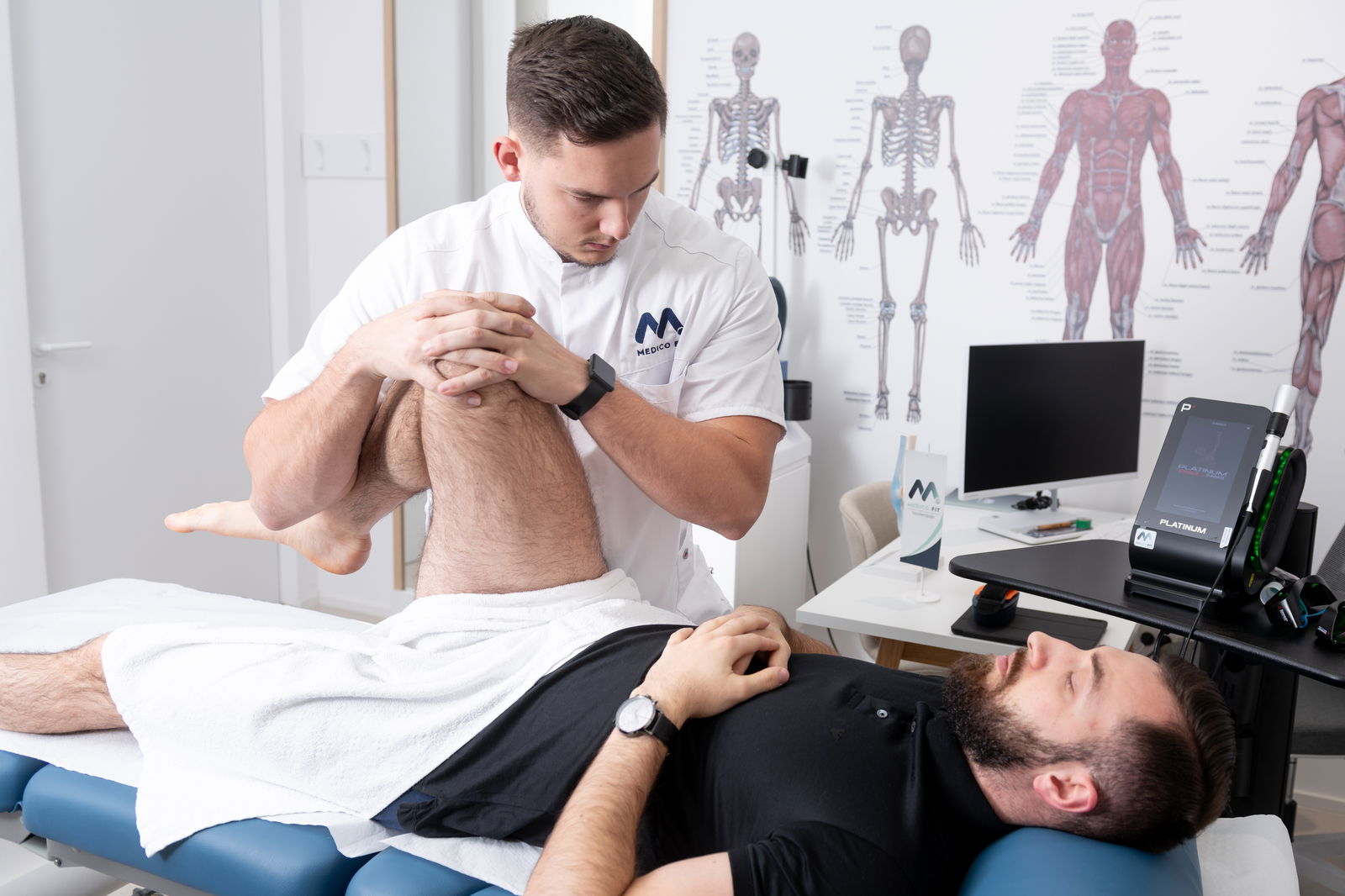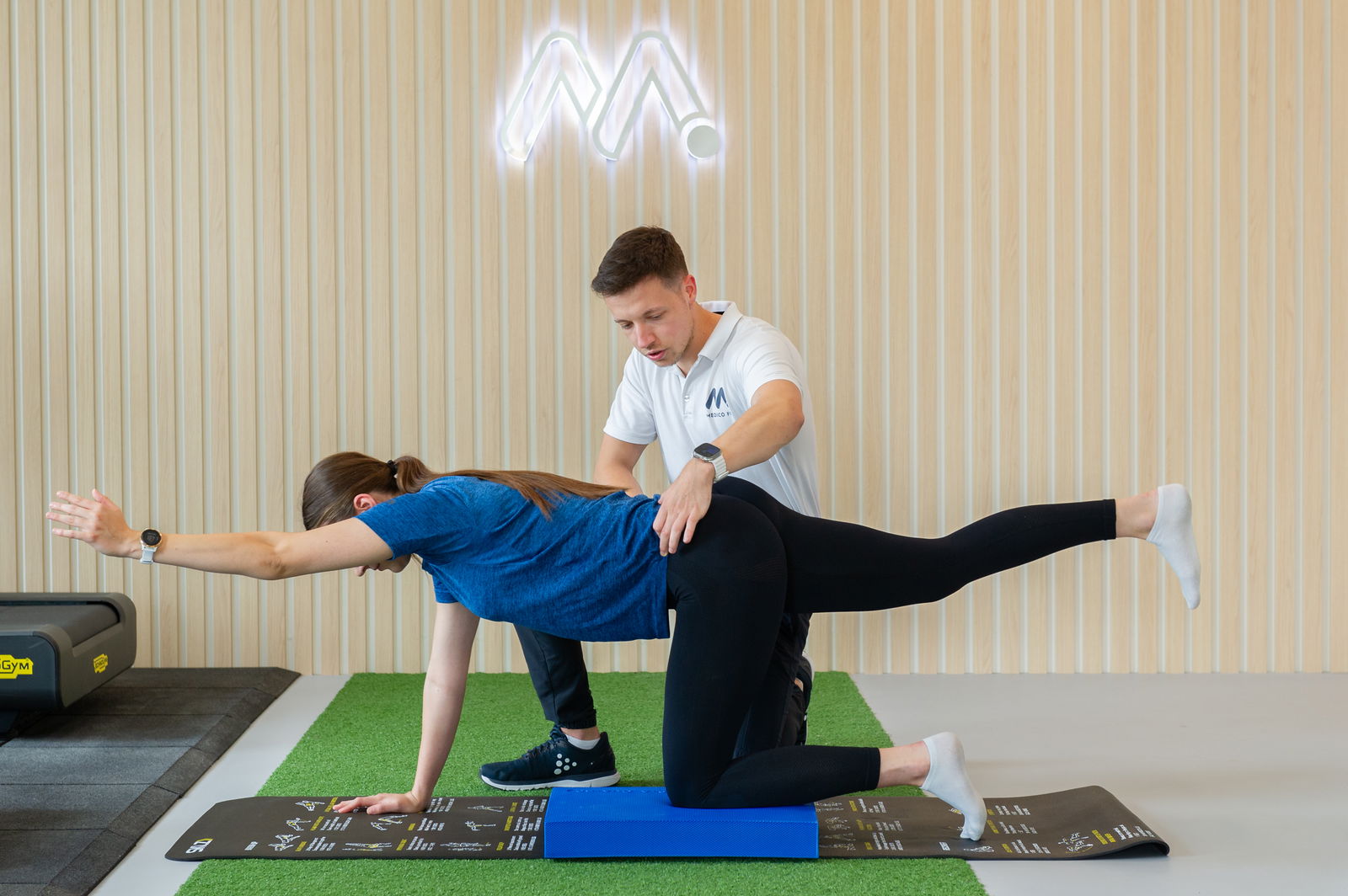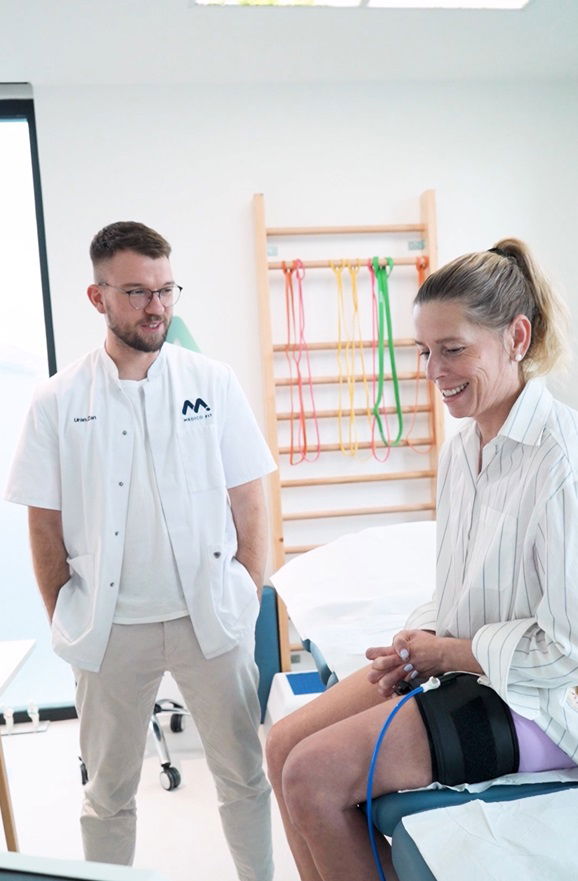Physiotherapy is perceived within the scope of healthcare services as a very broad area of therapeutic services for managing issues of the musculoskeletal system, which includes muscles, joints and ligaments.
All too often nowadays, patients report about ineffective physiotherapy and their problems that standard medical treatment has failed to resolve.
One of the leading reasons why physiotherapy is not effective for the patient is the so-called “quick” physiotherapy, which is too narrowly focused exclusively on managing the patient’s symptoms, which means that the patient basically has no chance of successful rehabilitation.
In this article, we will present the dangers of “quick” physiotherapy and some alternative forms of treatment of the musculoskeletal system, which actually have nothing in common with physiotherapy, as they do not include scientifically supported approaches in their therapy methods.
We will raise readers’ awareness of how important the choice of physiotherapy is for the comprehensive treatment of an injury or disease from the perspective of long-term treatment success.
Modern physiotherapy, which meets professional guidelines, is focused on the comprehensive treatment of disease or injury.
This means that symptom management is only one of the goals of rehabilitation, in which the entire therapeutic process is aimed at restoring full movement function and eliminating the underlying cause of the patient’s problems.
Why is the focus of physiotherapy exclusively on pain relief inappropriate and risky?
The patient must be aware that pain is only one of the symptoms that present with a specific orthopaedic problem. Pain intensity is understandably the most obvious and disturbing symptom for the patient. Every chronic disease and joint injury is accompanied by a number of other symptoms/complications that are more important from a functional point of view.
Common symptoms/complications include partial or complete rupture of connective tissue, inflammation of connective tissue, swelling of the joint capsule, tendinopathy, muscle asymmetry, contracture, fibrosis of connective tissue, decreased muscle activation, muscle atrophy, reduced range of motion, impaired motor skills, complete or partial load intolerance, decreased motor control, decreased joint stability, compensatory movement patterns, etc.
Too much focus on pain relief only solves the patient’s most superficially experienced symptom, which may occur in interdependence or as a result of the other symptoms listed above.
Imagine that a patient has a wide range of symptoms/complications listed above, and the therapist is focused only on the pain. In this case, about 1–5% of the patient’s active symptoms are being treated, so such treatment makes no sense.
Patients are today becoming increasingly aware of this fact, but there is still a group of patients who believe in quick fixes, which is a common factor in the development of a chronic degenerative condition.
It is also important for patients to understand that pain itself and the severity of the injury are not linearly related.
A patient with seemingly innocuous symptoms may have an underlying extensive orthopaedic risk of impairment and already progressive degenerative signs. Conversely, a patient with unbearable pain may have a completely harmless condition that will be quickly remedied with basic therapy. Accurate physiotherapy diagnostics are crucial before starting any treatment.
At MEDICOFIT clinic, we resolve the issue of the complexity of orthopaedic problems with diagnostic therapy, which represents an innovation in patient treatment, enabling specialist comprehensive physiotherapy for every type of problem the patient faces.

Is therapy to promote healing the same as pain reduction?
It is important to be aware that therapy to reduce pain does not equal therapy to promote healing or anti-inflammatory therapy.
Quick physiotherapy will be specifically focused solely on reducing pain, which will return or occur cyclically if the remaining factors are not adequately addressed. In truth, this is a flawed model of problem solving that is strongly focused on finding the source of the pain rather than finding and analysing the patient’s actual problem.
Can the services of osteopaths, chiropractors, manual therapists, and other alternative forms of therapy replace physiotherapy for the comprehensive treatment of an injury?
The methods of chiropractors, osteopaths, and manual medicine can be extremely problematic because they are always focused on finding a “miracle” approach that will eliminate the patient’s pain.
Today, there is a whole spectrum of alternative forms of therapy that lack scientific evidence, but can temporarily relieve patients’ problems, and there is also the placebo effect.
These are often patients who may later develop serious orthopaedic disorders and wear of the joint surfaces, as their underlying pathological picture is not adequately addressed and risk factors remain active.
Because we now understand the complexity of orthopaedic problems from a scientific perspective, we are more often warning patients that alternative therapies are a commercial service that is not necessarily bad, but is not a suitable substitute for specialised comprehensive physiotherapy for chronic or traumatic problems of the musculoskeletal system.
Book a specialist physiotherapy appointment
Why is physiotherapy important for the comprehensive treatment of a patient's function?
It often happens that the therapist, in their pursuit of excessive pain relief, neglects the function of the damaged segment itself. In truth, it is the function of the segment that will ensure a high-quality or long-term positive outcome of the rehabilitation itself.
If the patient is not capable of good functional load, even basic activities of daily living can represent a risk factor and excessive strain. This can lead to cyclical problems, chronic conditions, and patient frustration.
Inadequately performed physiotherapy of the original injury is a very common cause of the chain of development of orthopaedic problems and chronic pain in clinical practice.
It is important to be aware that improvement in the function of the injured segment with the same pain constitutes progress in rehabilitation. This is a principle of modern physiotherapy, completely foreign to general physiotherapy practice, which understands only and exclusively pain. As a result, the process is more difficult to understand for patients who make the transition from “quick” physiotherapy to high-quality specialist physiotherapy.
From a rehabilitation perspective, the most important thing is to restore the patient’s motor function, as this will allow the patient to use the affected area normally, safely put it under load, and fully participate in their activities of daily living. This is a much more important goal than simply relieving pain.
The goal of “quick” physiotherapy is to reduce the pain that is present “today”. The goal of physiotherapy for comprehensive treatment is to restore long-term high quality of movement or life to the patient.
How is pain reduction related to improved patient function?
Improvement in function is generally well correlated with reduction in pain, meaning that they often go hand in hand. The problematic group of patients is those who progress very well in function, but whose pain remains active due to certain factors. If the patient is excessively “stressed” by pain, such rehabilitation is more difficult for both the therapist and the patient.
As a rule, high-quality rehabilitation that reduces pain will simultaneously improve function, and vice versa.
Often, the function of the segment itself is further affected by pain, which means that reducing pain is a prerequisite for improving function. In this case, it is important to address such pain, but with technology that simultaneously accelerates healing, has an anti-inflammatory effect, and has a biostimulating effect.

So when is “quick” physiotherapy problematic?
In practice, it often happens that pain is the only symptom or the only problem that the therapist recognises due to a lack of knowledge about physiotherapy diagnostics.
As a result, they focus excessively on the area of pain and use exclusively analgesic, instrumental and also manual agents, without devoting time to appropriate kinesiotherapy. We must be aware that in-depth physiotherapy diagnostics are not part of general educational programmes and courses – they are narrowly specialised fields of physiotherapy.
Why are patients too often advised to rest and stay inactive as the first measure of treatment or are discouraged from active kinesiotherapy?
It is a typical problem that has its roots in the public healthcare system. Due to the lack of contact with modern science and, primarily, the isolated operation of medical fields, the cohesiveness of appropriate professionalism of patient treatment is being lost.
Early active rehabilitation actually achieves much better results than complete patient rest. Since “quick” physiotherapy is the product of a prescription, and this is part of the public network, it is a practice that is transferred from certain doctors to physiotherapy, so patients are often provided only passive treatment or “quick” physiotherapy to reduce pain.
Early active physiotherapy has been the standard of modern treatment for more than two decades, and any story where a doctor advises a patient to rest and stay inactive is contrary to established modern practice in the treatment of musculoskeletal problems.
At best, such a story is sad, as the patient would have reduced pain more quickly and suffered less functional impairment if they had started appropriate physiotherapy in the early acute phase.
Why is kinesiotherapy important in physiotherapy for comprehensive treatment?
A common consequence of “quick” physiotherapy is therefore also the “dangerous” pitfall of discouraging the patient from reasonable kinesiotherapy while the pain is present.
Kinesiotherapy involves the specialisation of exercises for suitable use in different phases of rehabilitation. This means that a good kinesiotherapy experts knows how to adapt exercises for the patient’s acute pain phase. This is crucial primarily because muscle activation has an analgesic effect and relieves the load on the patient’s joint surfaces.
The decline in muscle function is a leading problem in orthopaedic pain, as it further weakens the area affected by pain. The load per square centimetre of the passive joint structure, which includes cartilage and ligaments, is consequently many times greater.
With kinesiotherapy, we interrupt the typical negative pain cycle, when the patient’s muscles are completely immobile due to pain, and as a result, the pain increases as muscle weakness becomes the main factor in overloading the same joint.
This is a common and dangerous phenomenon, which can, in the case of improper rehabilitation, escalate from a completely harmless pain, for example in the lumbar spine, to a serious orthopaedic disorder, which must then be treated surgically.
What is important when performing kinesiotherapy?
We must be aware that we should not overdo kinesiotherapy performed when pain is present in the active acute phase. It must be performed under the supervision of a physiotherapy specialist and extremely well planned, as the joint’s load tolerance is lower during this period.
It is also necessary to touch upon the phenomenon of pain itself as a form of symptom. The patient may experience pain that is not related to an actual orthopaedic disorder, in which case it is inadvisable to delay kinesiotherapy, as excessive rest can lead to actual problems and a deterioration in physical condition.
Book a specialist physiotherapy appointment
What is partial (acute) rehabilitation and how did it become the dominant form that is mistakenly perceived as the correct treatment method?
At MEDICOFIT clinic, we have been drawing attention to the problem of partial rehabilitation since 2021, when we accepted our first patient. In fact, our patients are divided into two groups of equal size. The first group are patients who are visiting a physiotherapy expert for the first time.
The second group are patients who visit us due to unsuccessful rehabilitation. The problem is evident and is mainly related to partial rehabilitation.
We speak of partial rehabilitation when the patient receives only pain relief. So the criterion for success for “quick” physiotherapy is reduced pain, which does not mean completed rehabilitation, but rather the successful completion of the first phase, which continues with the patient’s transition to a combined regimen of kinesiotherapy and outpatient therapy.
After partial rehabilitation, the patient may have completely eliminated pain, but will remain with extensive functional deficits that may have several levels of impairment.
We observe a lot of such cases in practice. Partial rehabilitation happens primarily because healthcare staff convince patients that their treatment has been successfully completed.
Generally speaking, partial rehabilitation is a successfully completed pain-relieving treatment within the framework of physiotherapy, without the appropriate kinesiotherapy progression, where patients would regain joint mobility, muscle strength, muscle symmetry, ligament-joint stability, preventive resistance, and full function.
Partial rehabilitation is not a wrong treatment method, it is a solid physiotherapy method that reduces pain and prepares the patient for kinesiotherapy.
What is problematic is the systematic deception of patients who believe that their problem has been resolved because the pain is gone, when in truth they have numerous functional deficits that lead to the recurrence of symptoms sooner or later.
If a patient has inadequate muscle activation, reduced muscle strength, incomplete joint mobility and low load tolerance of connective tissue, we can predict with almost certainty that there will be overloading even during activities of daily life and, consequently, new injuries or pathological conditions.

What is the most common mistake patients you encounter during diagnostic therapies at MEDICOFIT clinic make?
The main problems we encounter, which are not really the patients’ fault, are the issues that occur due to patients being insufficiently informed about their medical condition and their actual rehabilitation needs.
In practice, we often see that patients undergo surgical treatments without first inquiring about the necessary steps of preoperative preparation, possible consequences, and above all, how postoperative rehabilitation is performed and how long this rehabilitation lasts.
This information should be provided to them by healthcare professionals, but we often see that this does not happen, so patients are more or less left to fend for themselves after the surgery.
As a result, patients make mistakes that should not have happened. They can get caught up in the web of general physiotherapy with “quick” physiotherapy, various forms of alternative therapies, or remain inactive and resting for too long.
We have developed diagnostic therapy due to the complexity of evaluating a patient during their first visit, as the conditions affecting our patients today are abnormally diverse. In practice, this means that we can be visited by four patients with the same knee ligament injury or knee wear with the following medical history:
- Patient A waited for a physiotherapy prescription for three months.
- Patient B underwent various massages, manipulations, and other forms of alternative treatment.
- Patient C had general, i.e. “quick”, physiotherapy (partial rehabilitation), which ended several months ago.
- Patient D did therapy on their own following instructions from social networks and websites.
Although all patients have the same pathological condition, they have markedly different complications, meaning that each requires a tailored approach to specialist physiotherapy.
Unfortunately, the example described above is quite common today, so a solution was needed in the form of diagnostic therapy, which includes advanced physiotherapy diagnostics to prepare an appropriate rehabilitation plan.
We advise patients not to make the four mistakes described above. They should prioritise seeking out physiotherapy specialists and getting second opinions primarily from experts in the relevant field.
Not every physiotherapist is a physiotherapy specialist, and not every orthopaedist is an expert for a specific joint. An obvious problem is a family clinic, where patients are advised methods that have not been appropriate for decades, such as complete rest.

How dangerous is the excessively long waiting period for orthopaedic conditions?
A long waiting period can be quite dangerous for orthopaedic conditions, as waiting too long has permanent consequences in terms of movement impairment or a significant decline in function in the injured segment.
Acute pain, if not treated in a timely manner, becomes chronic, and chronic pain has negative effects on patients’ quality of life.
The second consequence is purely anatomical; specifically, joints can become quite stiff after injuries, and mobility and muscle strength become drastically reduced. In clinical practice, we also see cases where a patient has less than 15% of the prescribed muscle strength for a particular joint.
Rehabilitation consequently requires much more time to achieve normal function, and sometimes this is no longer possible, which is why early treatment is truly important.
Book a specialist physiotherapy appointment
What are the correct treatment criteria for modern physiotherapy?
The main criteria of modern physiotherapy must be defined from all sides primarily from the perspective of function. Only then can we speak of a high-quality completed rehabilitation that will provide the patient with long-lasting effects.
The patient must therefore achieve certain functional norms. Literature, clinical research, and successful rehabilitation practices provide many guidelines for what normative standards of muscle strength without the presence of pain should be for various pathological conditions.
What are the goals of comprehensive treatment in comparison to general physiotherapy, which only treats symptoms?
Our goals are not just to eliminate symptoms or primary pain, but to achieve functional standards that are tailored to the individual patient based on their pathological condition.
Our goal is to achieve full rehabilitation of the patient’s function, which also includes targeting remaining risk factors in adjacent joints that could lead to re-injury or pain.
You can find an in-depth answer in the article:The main differences between general and specialist physiotherapy: Which to choose?
Comprehensive treatment is more difficult, but more permanent – why?
Treatment is more difficult because it seems longer solely at first glance. It is important to understand that if patients have had a certain problem for several years, their treatment has actually been ongoing for the entire period since the first occurrence of pain or injury. Many patients have actually been treating their problem this way for a very long time.
In this case, there are more or less successful episodes of physiotherapy and other forms of acute treatment and a cyclical recurrence of problems of the same origin, as partial rehabilitation has always been carried out without planning a comprehensive treatment until restoration of full motor function.
The comprehensive physiotherapy treatment approach of MEDICOFIT clinic is actually shorter and allows the patient to receive optimised treatment with specialist physiotherapy from their first treatment attempt.
It is a methodically planned rehabilitation that begins with diagnostic therapy and includes eliminating pain, acceleration of healing, and kinesiotherapy to restore full function.
After successful treatment, the patient can continue with a long-term programme of preventive individualised kinesiotherapy, which makes sense for complex injuries and progressive joint diseases.
In physiotherapy for comprehensive treatment of injuries and diseases, our position is that we will not promise or implement treatment that would only have short-term, quick effects, as this is not the correct physiotherapy approach.
During comprehensive treatment, the patient receives a lot of information about their pathological condition, as we want each patient to understand very well what is happening to them and why.
Each patient receives high-quality individual education to help them understand the onset of symptoms and why they have these problems, while at the same time we will eliminate risk factors that pose the possibility of long-term disorders during comprehensive treatment.
Patients who complete prescribed physiotherapy for the comprehensive treatment of injuries and diseases have much better function of the injured segment in the end and subsequently of the entire body.
The vision of MEDICOFIT clinic team is to help patients to return to a free and high-quality life through properly managed rehabilitation to increase the load-bearing capacity of damaged and undamaged tissues, as this is the only way to ensure a good long-term treatment outcome, easier participation in sports and activities of daily living, and subsequently a better quality of life.














